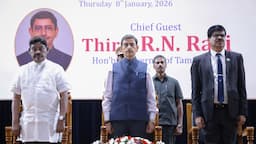Dr. Pavan Agrawal, pro-Vice Chancellor at Gwalior’s Vikrant University, underscores the necessity for agility and interdisciplinary collaboration in adapting to technological advancements with Education Post’s Prabhav Anand. He says: “Higher education institutions must be proactive in adapting to technological advancements to prepare graduates for future challenges.”
Q. With your experience in both academic and industrial settings, how do you think higher education institutions will need to adapt to keep up with the fast changing technological landscape? Specifically, in fields like mechanical engineering where developments in areas such as machine learning and the Internet of Things are transforming traditional practices?

Higher education institutions in fields like Engineering, Management and professional courses will need to be agile and proactive in responding to technological advancements to ensure that graduates are well-prepared for the challenges and opportunities of the future. Professional courses will indeed need to adapt to the fast-changing technological landscape to remain relevant and effective. Here are some ways they might do so:
Curriculum Revision:
Universities will need to update their curricula to incorporate emerging technologies such as machine learning, Internet of Things (IoT), and other advancements. This might involve adding new courses dedicated to these topics or integrating them into existing courses.
Interdisciplinary Approach:
Given the interdisciplinary nature of many emerging technologies, universities may need to foster collaboration between departments. For example, in mechanical engineering, collaboration with computer science departments could be beneficial for integrating machine learning into design processes.
Hands-on Experience:
Providing students with hands-on experience with new technologies will be crucial. This might involve setting up labs equipped with the latest tools and equipment, as well as offering opportunities for internships or industry placements where students can work with cutting-edge technology.
Emphasis on Problem-Solving and Critical Thinking:
While technological skills are important, universities should also emphasize problemsolving, critical thinking, and adaptability. These skills will be essential for navigating the rapidly changing technological landscape throughout students’ careers.
Research Focus:
Universities should continue to invest in research in emerging technologies to stay at the forefront of innovation. This research can not only contribute to advancements in the field but also inform teaching practices and curriculum development.
Q. Your research interests span diverse areas such as vibration signature analysis, soft computing, and machine learning techniques. How do you envision interdisciplinary collaboration playing a role in addressing complex engineering challenges, and what strategies do you employ to foster such collaborations within the academic environment of Vikrant University?
Interdisciplinary collaboration plays a crucial role in addressing complex engineering challenges because many of these challenges require expertise from multiple domains. By bringing together researchers from different fields, interdisciplinary collaboration can lead to innovative solutions that might not be possible within a single discipline. Interdisciplinary collaboration allows for a more holistic approach to problem-solving. Instead of focusing narrowly on one aspect of a problem, researchers can consider multiple factors and their interactions, leading to more comprehensive solutions.
To foster interdisciplinary collaboration within the academic environment of Vikrant University, I have employed the following strategies:
Create Interdisciplinary Research Centers:
Establishing interdisciplinary research centers or institutes within the university can provide a dedicated space for researchers from different disciplines to come together and collaborate on common goals.
Promote Cross-Departmental Seminars and Workshops:
Organizing seminars, workshops, and conferences that bring together researchers from different departments can facilitate knowledge exchange and foster collaboration.
Encourage Joint Research Projects:
Encouraging and supporting joint research projects that involve researchers from multiple disciplines can provide opportunities for interdisciplinary collaboration.
Provide Funding Opportunities:
Offering funding opportunities specifically targeted at interdisciplinary research projects can incentivize collaboration and support the development of innovative solutions to engineering challenges.
By implementing these strategies, Vikrant University is creating a vibrant interdisciplinary research environment that fosters collaboration and drives innovation in addressing complex engineering challenges.
Q. In a country like India where there is a growing emphasis on innovation and entrepreneurship, how do you believe universities can better nurture and support aspiring engineers to transition from academia to industry seamlessly, ensuring that their skills are aligned with market demands and technological advancements?
In India, as in many other countries, there’s a growing recognition of the importance of innovation and entrepreneurship in driving economic growth and societal development. Universities play a crucial role in nurturing and supporting aspiring engineers to transition from academia to industry seamlessly while ensuring their skills are aligned with market demands and technological advancements. Here are some strategies universities in India can employ:
Industry-Academia Collaboration:
Universities can strengthen ties with industry through collaborative research projects, internships, and industry-sponsored programs. Also ensure that students are exposed to real-world challenges and gain relevant skills that are aligned with market demands.
Entrepreneurship Education:
Universities can incorporate entrepreneurship education into their curriculum to cultivate an entrepreneurial mindset among engineering students. By providing students with the necessary knowledge and skills to start their own ventures, universities can empower them to pursue entrepreneurial opportunities.
Skill Development Programs:
Universities can offer skill development programs that focus on emerging technologies and industry-relevant skills. This can include training programs on topics such as artificial intelligence, data science, cyber-security etc. By equipping students with in-demand skills, universities can enhance their employability and readiness for the job market
Research and Innovation Hubs:
Establishing research and innovation hubs within universities can create a conducive environment for interdisciplinary collaboration and technology commercialization. These hubs can serve as incubators for startups, provide access to funding and mentorship, and facilitate technology transfer from academia to industry.
By implementing these strategies, universities in India can better nurture and support aspiring professional’s to transition from academia to industry seamlessly, ensuring that their skills are aligned with market demands and technological advancements.
Q. As someone who has secured numerous government-funded projects from various agencies, including AICTE, MPCST, and ministries like Minority Affairs and Housing & Urban Affairs, what insights can you share regarding the challenges and opportunities associated with conducting research in partnership with government entities, and how do such collaborations contribute to the overall academic and societal impact of the university?
Collaboration with government entities provides access to funding support for research projects, which can help universities sustain their research activities and invest in infrastructure and talent development. Collaborative research projects contribute to the advancement of knowledge in various fields, generating new insights, discoveries, and solutions to pressing societal challenges.
Government-funded projects provide opportunities for capacity building and skill development among researchers, students, and other stakeholders involved in project implementation. Research conducted in collaboration with government entities often leads to technology transfer, innovation, and commercialization opportunities. Academic institutions can leverage research outcomes to develop products, services, and solutions that benefit society and stimulate economic growth.
Q. With the proliferation of online learning platforms and the increasing availability of Massive Open Online Courses (MOOCs), how do traditional universities like Vikrant University remain relevant and competitive in attracting and retaining students, particularly in the context of offering specialized courses in emerging fields such as data science and artificial intelligence?
Vikrant University can remain relevant and competitive in the face of the proliferation of online learning platforms and MOOCs by leveraging their unique strengths and adopting innovative strategies.
Vikrant University has a long-standing reputation for providing quality education and is accredited by relevant authorities. They can emphasize the value of accredited degrees and the credibility of their faculty in attracting and retaining students.
Personalized Learning Experience: While online learning platforms offer flexibility and convenience, traditional universities can differentiate themselves by providing a personalized learning experience. This can include smaller class sizes, interactive discussions, hands-on projects, and one-on-one interactions with faculty members.
Access to Resources and Facilities: Traditional universities typically have access to extensive resources and facilities, including libraries, laboratories, research centers, and campus amenities. They can highlight these resources as part of the overall student experience and learning environment.
Integration of Online Learning: Rather than seeing online learning platforms as competitors, traditional universities can integrate them into their offerings. They can supplement traditional classroom instruction with online resources, flipped classroom models, and blended learning approaches to enhance student engagement and learning outcomes.
Specialized Programs and Research Opportunities: Traditional universities can develop specialized programs in emerging fields such as data science and artificial intelligence to meet the demand for skills in these areas. They can leverage their faculty expertise and research capabilities to offer cutting-edge curriculum and research opportunities to students.
Continuous Improvement and Adaptation: To remain competitive, traditional universities must continuously assess market demand, industry trends, and student preferences. They should be agile and adaptive in updating their curriculum, programs, and teaching methodologies to stay relevant in rapidly evolving fields such as data science and artificial intelligence.
Q. As a member of professional bodies and organizations like the Social Club and various engineering associations, how do you advocate for the integration of ethical considerations and social responsibility within engineering education, ensuring that future engineers not only possess technical expertise but also uphold values of integrity and community engagement?
As a member of professional bodies and organizations like social and engineering associations, advocating for the integration of ethical considerations and social responsibility within engineering education is crucial for ensuring that future engineers not only possess technical expertise but also uphold values of integrity and community engagement. Here’s how I might approach this advocacy:
Promoting Ethical Frameworks:
Encourage the adoption of ethical frameworks and codes of conduct within engineering education curriculum. This can involve advocating for the inclusion of courses or modules on ethics, professionalism, and social responsibility.
Encouraging Service Learning:
Promote service learning initiatives that allow engineering students to apply their technical skills to address real-world challenges in their communities. Service learning projects can foster a sense of social responsibility and empathy among students while providing valuable learning experiences.
Mentoring and Role Modeling:
Serve as a mentor and role model for students, emphasizing the importance of integrity, honesty, and accountability in engineering practice. Share personal experiences and insights that highlight the ethical dilemmas and challenges faced by engineers in their careers.
By actively advocating for the integration of ethical considerations and social responsibility within engineering education, professionals can help cultivate a new generation of engineers who are not only technically proficient but also ethical, responsible, and committed to serving the needs of society.
Q. Given your significant contributions to academic publications, including research papers, books, and book chapters, how do you balance your responsibilities as an administrator and educator with your commitment to scholarly research, and what advice would you offer to young academics looking to establish themselves as prolific researchers while juggling multiple roles within the university ecosystem?
Balancing responsibilities as an administrator, educator, and prolific researcher can be challenging, but it’s certainly achievable with effective time management, prioritization, and a strategic approach. Here’s how I might balance these roles and offer advice to young academics looking to establish themselves as prolific researchers while juggling multiple responsibilities:
Time Management:
Allocate dedicated time slots for each of your roles, including administrative tasks, teaching responsibilities, and research activities. Use tools like calendars, to-do lists, and time-blocking techniques to organize your schedule and ensure that you devote sufficient time to each area.
Prioritization:
Identify your key priorities within each role and focus your efforts on tasks that have the highest impact or urgency. Learn to distinguish between tasks that are important versus those that are merely urgent, and allocate your time accordingly.
Efficiency and Productivity:
Develop efficient workflows and strategies to maximize your productivity in research activities. This might involve setting aside uninterrupted blocks of time for focused writing or research, minimizing distractions, and leveraging technology tools to streamline tasks such as literature reviews and data analysis.
Set Realistic Goals:
Set realistic and achievable goals for your research projects, taking into account your other responsibilities and time constraints. Break down larger projects into smaller, manageable tasks, and track your progress to stay on target.
Stay Organized:
Maintain a well-organized workspace, both physically and digitally, to facilitate efficient work processes. Keep track of deadlines, milestones, and important documents related to your research projects, teaching responsibilities, and administrative duties.

Seek Support and Mentorship:
Don’t hesitate to seek support and guidance from mentors, colleagues, or support networks within your academic community.
For young academics looking to establish themselves as prolific researchers while juggling multiple roles within the university ecosystem, my advice would be to prioritize effectively, manage time efficiently, seek support when needed, and maintain a healthy work-life balance. By adopting strategic approaches to balancing responsibilities and staying focused on their research goals, they can successfully navigate the demands of academia while making meaningful contributions to their field.
















